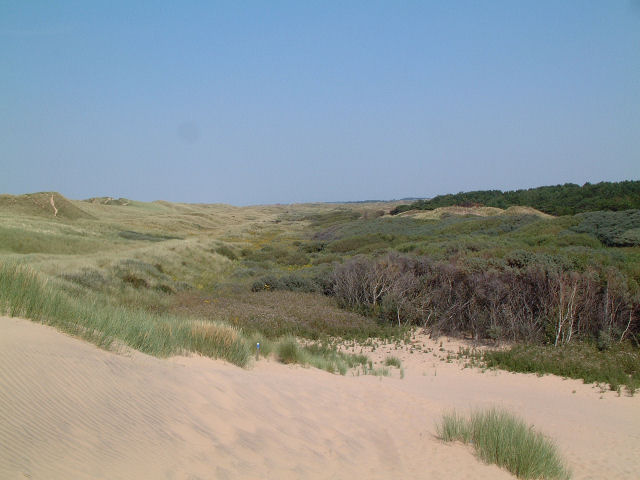Formby is located on the west coast of England, just a few miles below Southport and above Liverpool. The beach is accessed via wind-blown sand dunes or alternatively through a coppice of pine trees, which is home to one of the few colonies of red squirrels in Britain. Formby is also one of the few sites in Britain where Natterjack Toads breed and is also an important place for wading birds and an ecology that thrives in the unusual sand dunes area that is known geographically as a mobile dune system.
It is an area of special scientific interest (SSI)., and the beach area is managed by the National Trust. The erosion of the beach by the Irish Sea leaves exposed areas of prehistoric mud at low tides, and it is sometimes possible to see ancient human and animal footprints that were left in the mud 5000 years ago.

Gary Rogers / Foredunes at Formby
The name “Formby” was originally spelt “Fornebei” and has the meaning of “the old settlement” in the Norse language. The grade II listed manor house Formby Hall dates back to 1223 and is currently undergoing refurbishment. The former dower house to the hall is now a lovely pub; The Sparrowhawk and is a comfortable place to stop for refreshments.
The first lifeboat station of Great Britain was at Formby and dated back to 1776. Although you can find the foundations of the lifeboat station on the beach, there is no longer a lifeboat station at Formby.
When strolling along the Formby beach, there is a feeling of connection with ancient times; especially if you manage to visit when you have the beach all to yourself when you have climbed over the dunes onto the beach, it is as though the rest of the world doesn’t exist. The area has a unique beauty from the ever-shifting sand dunes, to the rolling tide and the beautiful sunsets as you watch the sun drop lower and lower and disappear into the sea. From the dunes on a clear day, it is possible to see the hills in Cumbria, notably Black Coombe in the Lake District in one direction and Snowdonia and the island of Anglesey, North Wales in the other. In the near distance are the bay’s wind turbines and Blackpool Tower.
Parking for the beach is easy and free at quiet times when the beach is busy; it may be necessary to use the chargeable car parks. At busier times the beach is a happy place with families and dogs playing in the sand and sea. For those who relish a longer coastal walk, there are plenty of opportunities to explore sandhills, sweeping dunes, further woodland and look out for wildlife and rare plants.
Holidaymakers head for the beaches of larger places such as Southport, Blackpool and Ainsdale, which are all nice sandy beaches, but for something special visit Formby.
